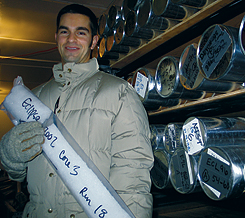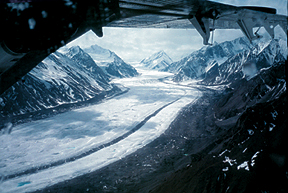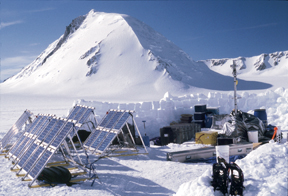Taking Core Science Into the Wild
IF A PICTURE is indeed worth a thousand words, next time graduate student Eric Kelsey gives one of his climate change talks to secondary school kids he might be able to say more with less.
Kelsey, a second-year Ph.D. candidate in the Climate Change Research Center spent the month of May digging snowpits and drilling shallow ice cores on glaciers in Alaska’s Denali National Park as part of his thesis work. The month-long reconnaissance mission, funded by the National Science Foundation, will identify specific drill sites for surface-to-bedrock ice cores and provide researchers with clear climate records going back some 2,000 years.
The fieldwork, led by CCRC scientist Cameron Wake and University of Maine colleague Karl Kruetz, is part of a decade-long goal to gather ice-core climate records from around the entire Arctic region. Shorter term, the effort will provide Kelsey with plenty of imagery to enliven his student talks, which are also part and parcel of his doctoral duties.
“I’ve had a number of wonderful opportunities to go to various schools and conferences in the area and give talks about what I do at CCRC, the fundamentals of climate change, and why it’s important,” says Kelsey, who had to leave behind his wife and 10-week-old daughter to carry out his first hardcore scientific field campaign.
“Most important of all,” he adds of his outreach efforts, “I talk about how energy and our lifestyles tie in to climate change and the humbling implications of it all if we’re really serious about fixing things.”
Kelsey earned a bachelor’s degree from the University of Missouri and a master’s from the University at Albany/SUNY—both in meteorology. But a desire to study longer-scale weather and climate variability landed him “right back in my backyard.” The Nashua native returned to his home state and found a good match in Wake as an advisor because of Wake’s focus on New England climate issues, ice cores, and climate change in general.
Moreover, Kelsey notes, he was enthusiastic that Wake, like other faculty at EOS, “encourages students to engage with other external partner organizations to do outreach scholarship, to help educate others, to put their research to work even in circumstances where it’s not directly related.”
Thus Kelsey’s climate change talks to groups around the region, like Coe-Brown Academy in Northwood, both the Oyster River high school and middle school in Durham, the Project WILD International Conference, and the Northeast Organic Farming Association Conference, to name several.
The fieldwork in Denali National Park (home of Denali a.k.a. Mount McKinley, the highest peak in North America at 20,320 feet) is the second leg of a multi-year NSF project.
Two years ago, Wake flew over Denali in an initial effort to identify potential drill sites. This year is the first time scientists have “had boots on the ground.”
Wake, Kelsey, UMaine’s Kruetz, post-doc Erich Osterberg, second-year M.S. candidate Ben Gross, undergraduate Seth Campbell, and Canadian ice-core driller Mike Waszkiewicz spent the month using a portable, ground-penetrating radar to determine the ice thickness and internal structure on various glaciers. Specifically, they looked for “layer-cake” ice with clear, well-defined annual stratigraphy.
The researchers also collected samples for chemical analysis from 20-foot-deep snowpits and shallow ice cores, and installed automatic weather stations at heights of 7,800 and 14,000 feet. The chemical analyses, which will be carried out at both UNH and UMaine labs, are needed to decipher changes in temperature, atmospheric circulation, and environmental change—such as the phenomenon known as “Arctic haze,” which has brought heavily polluted air masses to the region for decades from North America, Europe, and Asia.
A clear record from Denali will help round out the bigger paleoclimate picture by adding critical information gathered from ice cores recovered in the North Pacific, all of which can be compared to a wealth of climate data already gathered in the North Atlantic region.
According to Wake, scientists have long thought that the North Atlantic region drives global climate changes. However, there are now indications that a change in the North Pacific might happen first and be followed by a North Atlantic response. “We need to better understand the relationship in terms of the timing and magnitude of climate change between these two regions,” he says.
The Denali ice cores will complement others gathered over the years from around the Arctic as part of an overall effort to get a clearer, fuller picture of climate change. Moreover, complementing the ice core data are analyses done on tree rings, glacial moraine, and marine and lake sediments from the North Pacific region.
Notes Wake, “We have very long ice core records from Greenland that go back 110,000 years and provide us with a wonderfully detailed record. But just as any one meteorological station can’t tell you about weather across the entire United States, you need a whole series of ice cores to understand the regional texture of climate variability across the entire Arctic.”
Ice cores have been drilled in Penny Ice Cap and Devon Ice Cap—both in the Eastern Canadian Arctic, and at three elevations in the Saint Elias range in the Yukon. One more field season is expected at Denali next year—to download data from the weather stations—and scientists then hope to begin the deep-drilling program in the spring of 2010, should the NSF fund the second phase of the project. The team hopes to recover surface-to-bedrock ice cores from glacial ice that is about 1,000 feet thick. This length of core should provide a detailed record of climate and environmental change extending back several thousand years.
By taking ice cores in distinctly different climatic zones in the Northern Pacific—for example, the Saint Elias range is hard against the Gulf of Alaska while Denali is more interior—the researchers will be able to decipher smaller-scale, local variability with more regional climate variability. This, in turn, will help paint a clearer big picture with respect to the North Pacific and North Altantic.
“With respect to understanding global climate change,” explains Wake, “we want to know how these different regions compare to each other, we want to know what the driver is, which one is changing first and which is following. And so developing these high-resolution records that are directly comparable is really important.”
In addition to getting some valuable props, i.e., stunning photographs, for his climate change talks, the trip will give Kelsey a chance to further hone his outreach skills. As they set out for Denali National Park, the plan was for the intrepid researchers to give a presentation or two to park employees on what their research was all about and why it is important.
Explains Wake, “Sharing our research plans with the park rangers and local citizens on this trip represents the beginning of a larger engaged outreach effort we are developing with Denali National Park. We hope the results of our research will eventually provide park visitors with a better understanding of how the climate in central Alaska is changing and what it means for the future of the park and the region.”
Kelsey, a second-year Ph.D. candidate in the Climate Change Research Center spent the month of May digging snowpits and drilling shallow ice cores on glaciers in Alaska’s Denali National Park as part of his thesis work. The month-long reconnaissance mission, funded by the National Science Foundation, will identify specific drill sites for surface-to-bedrock ice cores and provide researchers with clear climate records going back some 2,000 years.
The Saint Elias Mountains from the window of a twin otter aircraft en route to an ice core drill site in May 2002. Photo: Cameron Wake, UNH-EOS |
“I’ve had a number of wonderful opportunities to go to various schools and conferences in the area and give talks about what I do at CCRC, the fundamentals of climate change, and why it’s important,” says Kelsey, who had to leave behind his wife and 10-week-old daughter to carry out his first hardcore scientific field campaign.
“Most important of all,” he adds of his outreach efforts, “I talk about how energy and our lifestyles tie in to climate change and the humbling implications of it all if we’re really serious about fixing things.”
Kelsey earned a bachelor’s degree from the University of Missouri and a master’s from the University at Albany/SUNY—both in meteorology. But a desire to study longer-scale weather and climate variability landed him “right back in my backyard.” The Nashua native returned to his home state and found a good match in Wake as an advisor because of Wake’s focus on New England climate issues, ice cores, and climate change in general.
 |
Eric KelseyPhoto: David Sims, UNH-EOS |
Thus Kelsey’s climate change talks to groups around the region, like Coe-Brown Academy in Northwood, both the Oyster River high school and middle school in Durham, the Project WILD International Conference, and the Northeast Organic Farming Association Conference, to name several.
The fieldwork in Denali National Park (home of Denali a.k.a. Mount McKinley, the highest peak in North America at 20,320 feet) is the second leg of a multi-year NSF project.
Two years ago, Wake flew over Denali in an initial effort to identify potential drill sites. This year is the first time scientists have “had boots on the ground.”
Wake, Kelsey, UMaine’s Kruetz, post-doc Erich Osterberg, second-year M.S. candidate Ben Gross, undergraduate Seth Campbell, and Canadian ice-core driller Mike Waszkiewicz spent the month using a portable, ground-penetrating radar to determine the ice thickness and internal structure on various glaciers. Specifically, they looked for “layer-cake” ice with clear, well-defined annual stratigraphy.
The researchers also collected samples for chemical analysis from 20-foot-deep snowpits and shallow ice cores, and installed automatic weather stations at heights of 7,800 and 14,000 feet. The chemical analyses, which will be carried out at both UNH and UMaine labs, are needed to decipher changes in temperature, atmospheric circulation, and environmental change—such as the phenomenon known as “Arctic haze,” which has brought heavily polluted air masses to the region for decades from North America, Europe, and Asia.
A clear record from Denali will help round out the bigger paleoclimate picture by adding critical information gathered from ice cores recovered in the North Pacific, all of which can be compared to a wealth of climate data already gathered in the North Atlantic region.
According to Wake, scientists have long thought that the North Atlantic region drives global climate changes. However, there are now indications that a change in the North Pacific might happen first and be followed by a North Atlantic response. “We need to better understand the relationship in terms of the timing and magnitude of climate change between these two regions,” he says.
The Denali ice cores will complement others gathered over the years from around the Arctic as part of an overall effort to get a clearer, fuller picture of climate change. Moreover, complementing the ice core data are analyses done on tree rings, glacial moraine, and marine and lake sediments from the North Pacific region.
Notes Wake, “We have very long ice core records from Greenland that go back 110,000 years and provide us with a wonderfully detailed record. But just as any one meteorological station can’t tell you about weather across the entire United States, you need a whole series of ice cores to understand the regional texture of climate variability across the entire Arctic.”
Ice cores have been drilled in Penny Ice Cap and Devon Ice Cap—both in the Eastern Canadian Arctic, and at three elevations in the Saint Elias range in the Yukon. One more field season is expected at Denali next year—to download data from the weather stations—and scientists then hope to begin the deep-drilling program in the spring of 2010, should the NSF fund the second phase of the project. The team hopes to recover surface-to-bedrock ice cores from glacial ice that is about 1,000 feet thick. This length of core should provide a detailed record of climate and environmental change extending back several thousand years.
Previous ice core expeditions, like this one in the Canadian Yukon, are part of an effort to understand climate variability across the entire Arctic Region. Photo: Cameron Wake, UNH-EOS |
“With respect to understanding global climate change,” explains Wake, “we want to know how these different regions compare to each other, we want to know what the driver is, which one is changing first and which is following. And so developing these high-resolution records that are directly comparable is really important.”
In addition to getting some valuable props, i.e., stunning photographs, for his climate change talks, the trip will give Kelsey a chance to further hone his outreach skills. As they set out for Denali National Park, the plan was for the intrepid researchers to give a presentation or two to park employees on what their research was all about and why it is important.
Explains Wake, “Sharing our research plans with the park rangers and local citizens on this trip represents the beginning of a larger engaged outreach effort we are developing with Denali National Park. We hope the results of our research will eventually provide park visitors with a better understanding of how the climate in central Alaska is changing and what it means for the future of the park and the region.”
by David Sims, Science Writer, Institute for the Study of Earth, Oceans, and Space. Published in Spring 2008 issue of EOS .


